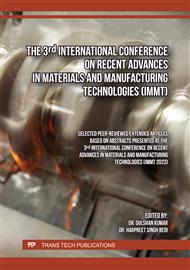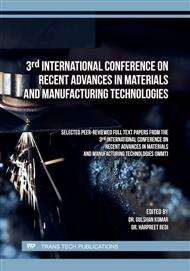[1]
A.A. Rosli, R.K. Shuib, K.M.K. Ishak, Z.A.A. Hamid, M.K. Abdullah, A. Rusli, Influence of bed temperature on warpage, shrinkage and density of various acrylonitrile butadiene styrene (ABS) parts from fused deposition modelling (FDM), AIP Conf. Proc. 2267(1) (2020) 020072
DOI: 10.1063/5.0015799
Google Scholar
[2]
S. Guessasma, W. Zhang, J. Zhu, S. Belhabib, H. Nouri, Challenges of additive manufacturing technologies from an optimisation perspective, Int. J. Simul. Multidiscip. Des. Optim. 6 (2015) A9 1-13
DOI: 10.1051/smdo/2016001
Google Scholar
[3]
O.A. Mohamed, S.H. Masood, J.L. Bhowmik, Optimization of fused deposition modeling process parameters: a review of current research and future prospects, Adv. Manuf. 3 (2015) 42-53
DOI: 10.1007/s40436-014-0097-7
Google Scholar
[4]
M.K. Thompson, G. Moroni, T. Vaneker, G. Fadel, R.I. Campbell, I. Gibson, A. Bernard, J. Schulz, P. Graf, B. Ahuja, F. Martina, Design for Additive Manufacturing: Trends, opportunities, considerations, and constraints, CIRP Ann. 65(2) (2016) 737-760
DOI: 10.1016/j.cirp.2016.05.004
Google Scholar
[5]
G. Moroni, W.P. Syam, S. Petrò, Functionality-based part orientation for additive manufacturing, Proc. CIRP 36 (2015) 217-222.
DOI: 10.1016/j.procir.2015.01.015
Google Scholar
[6]
W. Gao, Y. Zhang, D. Ramanujan, K. Ramani, Y. Chen, C.B. Williams, C.C. Wang, Y.C. Shin, S. Zhang, P.D. Zavattieri, The status, challenges, and future of additive manufacturing in engineering, Comput. Aided Des. 69 (2015) 65-89.
DOI: 10.1016/j.cad.2015.04.001
Google Scholar
[7]
A.N. Dickson, H.M. Abourayana, D.P. Dowling, 3D printing of fibre-reinforced thermoplastic composites using fused filament fabrication – A review, Polym. 12(10) (2020) 2188.
DOI: 10.3390/POLYM12102188
Google Scholar
[8]
P. Zhuo, S. Li, I.A. Ashcroft, A.I. Jones, Material extrusion additive manufacturing of continuous fibre reinforced polymer matrix composites: A review and outlook, Compos. B Eng. 224 (2021) 109143.
DOI: 10.1016/j.compositesb.2021.109143
Google Scholar
[9]
H. Mei, Z. Ali, Y. Yan, I. Ali, L. Cheng, Influence of mixed isotropic fiber angles and hot press on the mechanical properties of 3D printed composites, Addit. Manuf. 27 (2019) 150-158.
DOI: 10.1016/j.addma.2019.03.008
Google Scholar
[10]
G. Liu, Y. Xiong, L. Zhou, Additive manufacturing of continuous fiber reinforced polymer composites: Design opportunities and novel applications, Compos. Commun. 27 (2021) 100907.
DOI: 10.1016/j.coco.2021.100907
Google Scholar
[11]
M. Khorasani, A. Ghasemi, B. Rolfe, I. Gibson, Additive manufacturing a powerful tool for the aerospace industry, Rapid Prototyp. J. 28(1) (2022) 87-100.
DOI: 10.1108/RPJ-01-2021-0009
Google Scholar
[12]
S. Sharafi, M.H. Santare, J. Gerdes, S.G. Advani, A review of factors that influence the fracture toughness of extrusion-based additively manufactured polymer and polymer composites, Addit. Manuf. 38 (2021) 101830.
DOI: 10.1016/j.addma.2020.101830
Google Scholar
[13]
I.J. Solomon, P. Sevvel, J.J.M.T.P. Gunasekaran, A review on the various processing parameters in FDM, Mater. Today Proc. 37 (2021) 509-514.
DOI: 10.1016/j.matpr.2020.05.484
Google Scholar
[14]
L. Auffray, P.A. Gouge, L. Hattali, Design of experiment analysis on tensile properties of PLA samples produced by fused filament fabrication, J. Adv. Manuf. Technol. 118 (2022) 4123-4137.
DOI: 10.1007/s00170-021-08216-7
Google Scholar
[15]
R. Shuto, S. Norimatsu, D.D. Arola, R. Matsuzaki, Effect of the nozzle temperature on the microstructure and interlaminar strength in 3D printing of carbon fiber/polyphenylene sulfide composites, Compos. C Open Access 9 (2022) 100328.
DOI: 10.1016/j.jcomc.2022.100328
Google Scholar
[16]
S. Nathaphan, W. Trutassanawin, Effects of process parameters on compressive property of FDM with ABS, Rapid Prototyp. J. 27(5) (2021) 905-917.
DOI: 10.1108/RPJ-12-2019-0309
Google Scholar
[17]
M. Algarni, S. Ghazali, Comparative study of the sensitivity of PLA, ABS, PEEK, and PETG's mechanical properties to FDM printing process parameters, Cryst. 11(8) (2021) 995.
DOI: 10.3390/cryst11080995
Google Scholar
[18]
Z. Zhang, D. Yavas, Q. Liu, D. Wu, Effect of build orientation and raster pattern on the fracture behavior of carbon fiber reinforced polymer composites fabricated by additive manufacturing, Addit. Manuf. 47 (2021) 102204.
DOI: 10.1016/j.addma.2021.102204
Google Scholar
[19]
I.M. Alarifi, A performance evaluation study of 3d printed nylon/glass fiber and nylon/carbon fiber composite materials, J. Mater. Res. Technol. 21 (2022) 884-892.
DOI: 10.1016/j.jmrt.2022.09.085
Google Scholar
[20]
Z. Yang, Z. Yang, H. Chen, W. Yan, 3D printing of short fiber reinforced composites via material extrusion: Fiber breakage, Addit. Manuf. 58 (2022) 103067.
DOI: 10.1016/j.addma.2022.103067
Google Scholar
[21]
N. Magino, J. Köbler, H. Andrä, F. Welschinger, R. Müller, M. Schneider, A space-time upscaling technique for modeling high-cycle fatigue-damage of short-fiber reinforced composites, Compos. Sci. Technol. 222 (2022) 109340.
DOI: 10.1016/j.compscitech.2022.109340
Google Scholar
[22]
Y. Abderrafai, M.H. Mahdavi, F. Sosa-Rey, C. Hérard, I.O. Navas, N. Piccirelli, M. Lévesque, D. Therriault, Additive manufacturing of short carbon fiber-reinforced polyamide composites by fused filament fabrication: Formulation, manufacturing and characterization, Mater. Des. 214 (2022) 110358.
DOI: 10.1016/j.matdes.2021.110358
Google Scholar



